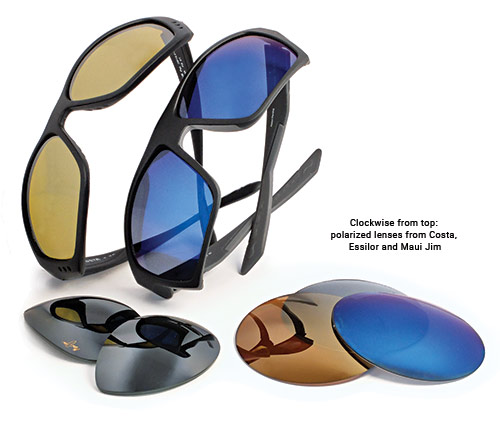
By Palmer R. Cook, OD
Nearly everyone in the ophthalmic industry uses and appreciates polarized lenses. Yet only about 8 percent of prescription sun lenses dispensed in the U.S. are polarized. There is definitely something wrong with that picture. One company producing high-end plano polarized as well as prescription polarized sunglasses estimates that approximately 20 percent of their products are prescription. If eyecare professionals embrace polarized technology, why aren’t the patients they care for similarly enthused?
As an ECP working with patients who need prescription lenses, you are in a perfect position to discuss the advantages of polarized sunglasses. One might expect that greater than 20 percent of your prescription sunglasses orders would be polarized. Your laboratory can probably provide your practice’s polarized versus non-polarized ratio if you simply request that information.
Are eyecare professionals inadvertently discouraging the use of polarized products? And if so, then how and why is that happening? Perhaps we should dig down to the fundamentals of how we are including polarized lenses in the family of eyecare products that we prescribe for our patients. Could it be that our patients are not really aware of the value of polarized protection? Can you and everyone on your staff honestly say that you enjoy the benefits of polarized lenses? And if you can say it, why don’t you say it?
Is every patient you examine given at least a couple of sentences in the post-exam consultation that deals with the importance of absorptive lenses, and does that information include the difference between standard sun lenses and the better performing polarized lens products? Do you and your staff members let your patients know how much you enjoy the clarity, comfort and improved vision provided by your own polarized sunglasses?
Figure 1
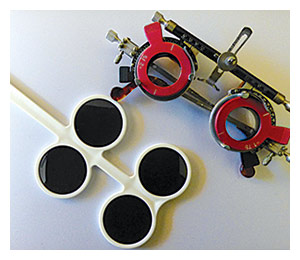
A trial frame and a lens flipper with polarized and non-polarized lenses make a good demonstration of the new Rx and the advantages of polarized sunglasses. It’s quick and easy, and it can be used with a polarizing demonstrator.
Figure 2
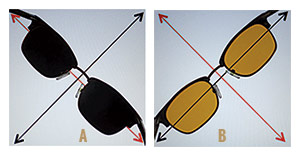
These correctly mounted polarized lenses show the blocking effect (photo A) when the absorption axis of the lens is in alignment with the direction of the vibration of the light emitted by this laptop screen (shown by the red arrow). When the eyewear is rotated 90 degrees (photo B) so the transmission axis of the lens is oriented at a right angle to the red arrow, it allows vertically polarized light to pass through the lens. Annoying, visually fatiguing and sometimes visually debilitating reflected light from horizontal surfaces such a snow, beaches, water, road surfaces and car tops, hoods and trunks is polarized and blocked as shown in photo A.
The benefits of polarized lenses are substantial, and those benefits should be understood by every one of your staff members. Polarized lenses are unique ophthalmic products. If your staff treats polarized as an “add-on,” you may have discovered a significant problem. Polarized lenses are truly a unique product. They selectively eliminate visually useless, sometimes dangerous and typically fatiguing light, and they pass light that forms better defined retinal images. But how do your patients learn that you have polarized lenses, and how do they learn about their benefits?
Many manufacturers of polarized lenses have demonstrators that make the advantages evident. Even better, using four-lens, lens-flippers with polarized and non-polarized sun lenses (Fig. 1) makes it quick and easy to demonstrate polarized lenses over a trial frame or over the patient’s existing clear lenses. These are easy-to-use tools, but don’t assume that your staff will intuitively understand how best to use them. (For more on polarized lens demonstrators, see the sidebar, “It’s Easy to Demonstrate Polarized Lenses” on page 94.)
Another easy demonstration is shown in Fig. 2. A lens flipper with polarized lenses and non-polarized lenses can also be used by patients to check the GPS screen in their cars, as well as to check the other instruments. An informal check of GPS screens in 2017 Toyota and Subaru models showed the driver with polarized sun lenses would need to tilt his head at a 45-degree angle to make the GPS screens lighter and most visible. The entire instrument panel and GPS screen of a high-end Audi was polarized, but the manufacturer had wisely shifted the axis of polarization so the instrument and GPS visibility was quite good for drivers with polarized lenses. The same proved true for several models of the 2017 Mercedes-Benz. No tilting was required for a better view.
The screen of several Garmin automotive GPS units worked well with polarized lenses. Even if the polarized lens requires a head tilt for a better view, that should be known before lenses are ordered. Dispensing tip: Let your patient know in advance that some dashboard instruments and some gas pumps may be best viewed with a head tilt—a small penalty to pay for the comfort and safety of polarized lenses for driving.
Figure 3
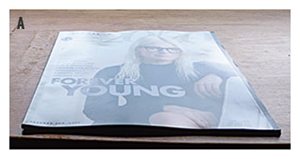
Fig. 3a This photograph was taken with the ophthalmic polarized lens correctly oriented to block reflected glare (horizontally vibrating light).
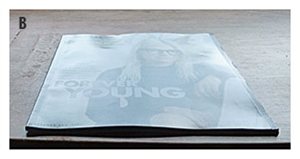
Fig. 3b This photo was taken through an ophthalmic gray polarized lens that has been rotated 90 degrees so the 180 meridian is vertical.
Figure 4
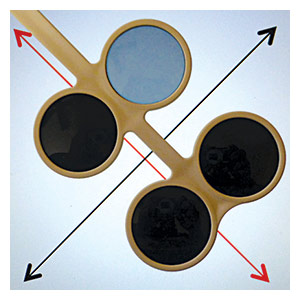
Three lenses in this flipper are correctly oriented with the absorption axes oriented to block horizontally vibrating light. The uppermost lens axis has been incorrectly oriented to align with the transmission axis, or vertical meridian, in polarized eyewear.
Just as there are standard lenses and better performing AR lenses that should be differentiated for patients, polarized lenses should be presented as a better performing product category compared to the performance of standard sun lenses. Some patients will want the best in whatever they get in health care, but many others will want to know the value they are purchasing. Regardless of patients’ motivations, it is important to dispense top quality, properly fabricated polarized lenses.
In creating a polarized lens, a filter, tinted to achieve an appropriate transmission level, is sandwiched into the lens blank. Polarized lenses theoretically cannot eliminate more that 50 percent of incident light, so some additional tint is typically added to achieve the absorption needed for sun protection. Polarized lenses should always be finished so the edge of the polarized, tinted film is concealed for a better appearance. Nylon cord mountings are best avoided for polarized lenses. Selecting a frame with a somewhat thicker eyewire makes it easier for your lab to conceal the edge of the filter.
The laminated layers of polarized lenses of years ago were prone to separating due to heat, materials contracting or expanding unevenly with temperature changes, or even as the result of using nylon cord mountings. Today various techniques are used to prevent delamination. Your lab should be able to advise you about the properties and manufacturer support that you can expect when fitting polarized lenses.
Occasionally a lab will edge and insert one lens to correctly block horizontally vibrating light rays, but the other lens is inadvertently edged so that it incorrectly blocks vertically vibrating light (Fig. 4). This causes an odd luster effect because one eye sees one level or brightness of reflected light, and the other eye sees another level of brightness. Many patients find this distressing because a binocular rivalry interferes with comfortable fusing of similar objects in the field of view that are seen by reflected polarized light. Occasionally such a patient will return saying that some things seem to shimmer or glimmer, but most will simply be on your doorstep saying, “There’s something not right about these sunglasses.” If both lenses were oriented incorrectly—a highly unlikely error (Fig. 3b)—your patient may not be on your doorstep again, ever.
Figure 5
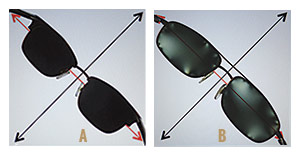
These photos show a check for areas of depolarization using a laptop. The eyewear is
oriented so that the 180-degree meridian of the eyewear parallels the orientation of polarization of light emitted by the screen (shown by the red arrows). Photo A on the left shows no areas of depolarization. The left frame has a flatter base curve and very little wrap. The lenses in photo B show significant areas of depolarization, but polarized glare is blocked in the center of both lenses. It is important to remember that these lightened areas cannot be seen except by polarized light sources. If your lab finds that the lenses will be too loose when edged down enough to relieve all the stress, the patient may need to either select a different frame or be satisfied with the reduced polarizing efficiency.
Figure 6
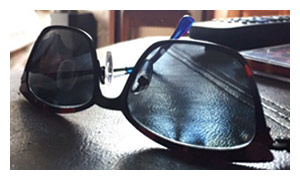
A newly dispensed pair of polarizing sunglasses was inadvertently left on a leather-upholstered piece of furniture. When sunlight was reflected from the leather and through the lenses, a patient in the UK was distressed to see that the lenses had significantly lightened, and sent photos and questions asking, “. . . what is wrong?” and, “Will my eyes be more visible to others.” The problem is that the lenses are too tightly mounted in the frame causing areas of depolarization, but to observers her eyes will not be more visible. Obviously this patient appreciates the mystique factor as part of the fashion statement made by sunglasses.
Figure 7
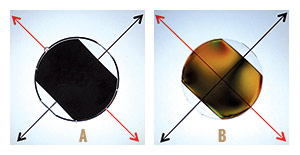 This poly polarizing lens is in front of a white laptop screen in both photos. The polarizing light emitted from the screen is vibrating in the 135-degree meridian (parallel to the red arrow). The minus, or concave side of the lens is toward your eye in photo A. In photo B, the plus or convex side of the lens is facing you, and normal stresses within poly causes a double refraction phenomenon or birefringence that produces a jumbled swirl of colors. This effect is not helpful if you are trying to determine
if both lenses in your patient’s eyewear have the correct orientation of polarization. However, the birefringence will not adversely affect your patient’s vision. When verifying polarizing lenses, always check the orientation of polarization as shown in the left photo with the concave side of the lens toward you. When the lens is edged, the meridian that parallels the flat edges of the laminated polarizing film within the lens must be oriented to fall in the 180-degree meridian of the eyewear.
This poly polarizing lens is in front of a white laptop screen in both photos. The polarizing light emitted from the screen is vibrating in the 135-degree meridian (parallel to the red arrow). The minus, or concave side of the lens is toward your eye in photo A. In photo B, the plus or convex side of the lens is facing you, and normal stresses within poly causes a double refraction phenomenon or birefringence that produces a jumbled swirl of colors. This effect is not helpful if you are trying to determine
if both lenses in your patient’s eyewear have the correct orientation of polarization. However, the birefringence will not adversely affect your patient’s vision. When verifying polarizing lenses, always check the orientation of polarization as shown in the left photo with the concave side of the lens toward you. When the lens is edged, the meridian that parallels the flat edges of the laminated polarizing film within the lens must be oriented to fall in the 180-degree meridian of the eyewear.
Polarized lenses have two axes, one is the “absorption axis,” which should be aligned with the 180-degree meridian of the sunglasses so that it blocks the horizontally vibrating light reflected from horizontal surfaces, and the other is the “transmission axis,” which is at 90 degrees to the absorption axis, and which passes vertically vibrating polarized light in polarized sunglasses.
An important part of “getting it right” when verifying polarized eyewear is to include two additional steps in your normal verification procedure. First, hold the eyewear with the back of the lenses toward you and view light reflecting off of a flat countertop or tabletop. With the eyewear held horizontally, the reflected light is dimmed in both lenses (Fig. 3a) giving a clearer image. Then by rotating the lenses 90 degrees, both lenses reveal more useless reflected light being transmitted by each lens (Fig. 3b). The second additional verification step is to put the lenses (after they are in the frame) in front of a known source of polarized light in order to look for patchy areas of depolarization (Fig. 5 and Fig. 6).
If your computer screen is not polarized, you can use a plano polarized lens, or even a polarized lens demonstrator for verification purposes. Always check polarized lenses for depolarization with the minus (concave) side of the lens toward you and with the top of the eyewear parallel to the vibration of the reflected light. In the case of reflected light from a horizontal, flat surface or from a polarized lens demonstrator, the eyewear would be held “level” or at right angles to gravity. If you are using a laptop screen as your source for polarized light, start with a polarized lens that blocks light reflected from a horizontal surface, and then determine the position the lens must be in to block light correctly from the computer screen. This will be the orientation you should use when checking lenses using the computer screen.
Be sure everyone on your staff has top-quality polarized sun lenses for their own use. Make educational discussions of polarized lenses part of your staff meetings. These discussions should include how the lenses work, why they are important for better vision and safety, and how to demonstrate polarized lenses with demonstrators available from various manufacturers. Lens flippers can be fitted with polarized and non-polarized plano lenses to demonstrate the benefit of the polarization. This should be done over a trial frame with the new Rx if at all possible.
THOSE WHO BENEFIT THE MOST
Your staff should know that the streamlined tilt of automobile windshields creates a veiling image of the dashboard that degrades the retinal image. This contributes to fatigue while driving. Even worse there have been serious accidents, some involving fatalities that have occurred as the result of reflected glare that could have been eliminated had the driver been using polarized lenses. On the more positive side, there have undoubtedly been accidents avoided by more fortunate drivers who owned polarized lenses.
Of course, automobile drivers are also subjected to polarized glare from many other sources such as car tops, trunk lids and trim, road surfaces and other parts of the environment. Although trucks typically have a more vertical windshield than automobiles, truckers are exposed to sources of reflected glare over much longer periods of time than people driving automobiles, and they are prime candidates for the benefits of polarized lenses.
This reflected glare is dangerous as well as fatiguing, and it can be effectively reduced using polarized sun lenses and specialty lenses such as Younger Optics’ DriveWear products. Most fisherman already know the advantage of eliminating glare from the water’s surface, but many patients may not realize the advantages of using polarized lenses for the beach. Both water and sand can create significant discomfort glare that can be eliminated by polarized lenses.
OUR SENIOR CITIZENS
Seniors often realize that night driving has become an issue and wisely restrict their driving to daylight hours. Seniors also have a longer glare recovery time, and legal-for-driving-but-reduced acuity levels and reaction times. The reduction of the veiling effect from the windshield and the elimination of flashes of reflected glare through the use of polarized lenses can make them more comfortable and safer for daylight driving. Of course, polarized lenses should never be used for night, dusk or dawn driving conditions.
Polarized lenses, just like AR lenses, have a tremendous advantage over some of the other significant improvements in eyewear technology. They provide benefits that are immediately patient perceptible and patient appreciated. Should polarized lenses be presented as an add-on when discussing prescription sunglasses? Probably not. Polarized lenses offer unique benefits that deserve to be presented in a category of quality performance of its own. ■
CAUTIONS
Pilots are not permitted to use polarized lenses when operating aircraft. Most commercially licensed pilots are aware of this regulation, but it applies to private pilots also. The primary
reasons for the restriction are: 1. Aircraft in level flight are seen by light, much of which is horizontally polarized and therefore blocked by polarized sun lenses. With closing speeds that may be in the triple digits or higher, anything that shortens the pilot’s response time to avoid a potential collision is contra-indicated. 2. Various cockpit instruments emit polarized light and may appear dimmed or non-functional when viewed through polarized lenses. Annotating your chart to indicate the patient was advised about this regulation and having it initialed by the patient would be a good idea.
Skiers make frequent, rapid judgments about snow and ice conditions, and their head position varies considerably as they twist and turn down a slope. Changing the head position rotates the absorptive axis (which is in the 180-degree meridian of polarized eyewear) and causes the surfaces they are viewing to vary in appearance. This should be discussed when your patient is considering his or her sunglass options.
Playing golf is generally not a high-risk activity, but many players take the game very seriously indeed. The light reflected from a grass surface can be partially polarized, and this could possibly be a problem.
-PC
IT’S EASY TO DEMONSTRATE POLARIZED LENSES
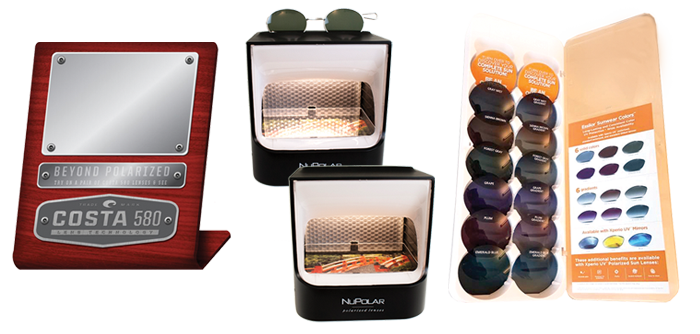
Selling polarized lenses is easier than you think—simply demonstrate them. Dispensing table displays such as those produced by Younger Optics, Costa and Essilor that are pictured here show how reflections block images on the display in the same way reflections block vision when driving. A polarized lens lorgnette allows the patient to look at the display and the reflected light obscuring the display is blocked. Only the display photo is visible. It’s that easy. Once the patient has worn polarized lenses, they’ll usually purchase them again.
Costa’s in-store demonstrator features a horizontal plaque with the words “Beyond Polarized” that can only be read while the patient is wearing Costa polarized lenses.
Younger Optics’ NuPolar LED Glare Demonstrator creates bright glare so that ECPs may demonstrate the power of polarized lenses to their patients. The unit is battery operated and lights up with the push of a button. It features an easy access on/off button on top and an automatic timed shut-off. It also includes a polarized lorgnette that rests on top of the unit when not in use. If desired, the demonstration image beneath the glare surface is able to be swapped with any one of four seasonal images included.
The NuPolar LED Glare Demonstrator is available to ECPs through laboratories for $50. Ten coupons for $5 off NuPolar lenses are included with each demonstrator.
Essilor offers a sample lens kit that dispensers can use to show patients how XPerio polarized lenses can provide a colorful view while blocking glare.
-Andrew Karp
Contributing editor Palmer R. Cook, OD, is an optometric educator and optical dispensing expert.
Special thanks to Younger Optics/NuPolar and ABB Optical Group/Diversified Ophthalmics for their technical support for this article.












